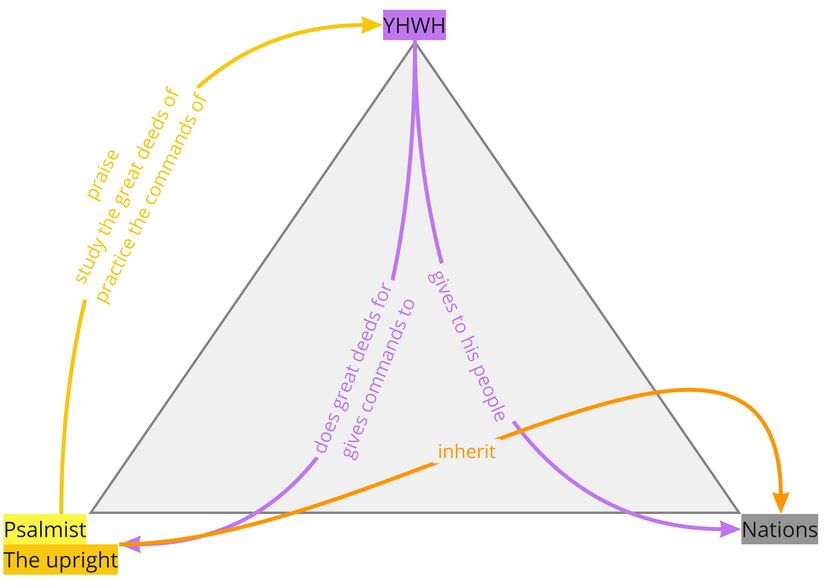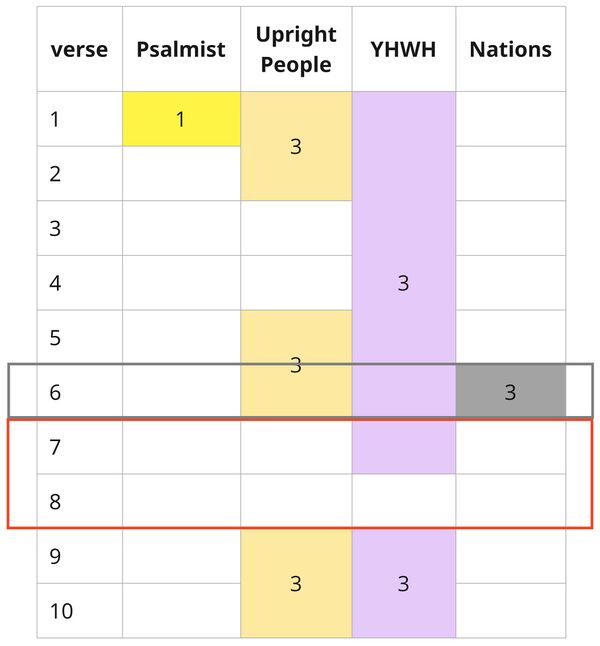Psalm 111 Participant Analysis
From Psalms: Layer by Layer
Psalm 111/Participant Analysis
Choose a PsalmNavigate Psalm 111
Participant Analysis
Participant Analysis focuses on the characters in the psalm and asks, “Who are the main participants (or characters) in this psalm, and what are they saying or doing? It is often helpful for understanding literary structure, speaker identification, etc.
For a detailed explanation of our method, see the Participant Analysis Creator Guidelines.
There are three participants/characters in Psalm 111:
Profile List
| Psalmist |
| Upright people |
| "The congregation" (v. 2) |
| "Those who delight in YHWH's deeds" (v. 2) |
| "Those who feared him" (v. 5) |
| "YHWH's people" (v. 6) |
| "Those who practice YHWH's commands" (v. 10) |
| YHWH |
| Nations |
Profile Notes
- Psalmist/Upright People: While the first-person singular reference in v. 1 constitutes a distinct participant, the psalmist presents himself as being present with the upright people, in the congregation (v. 1c). Thus, the psalmist describes himself as a subset of the upright people.
| Text (Hebrew) | Verse | Text (CBC) The Close-but-clear translation (CBC) exists to provide a window into the Hebrew text according to how we understand its syntax and word-to-phrase-level semantics. It is designed to be "close" to the Hebrew, while still being "clear." Specifically, the CBC encapsulates and reflects the following layers of analysis: grammar, lexical semantics, phrase-level semantics, and verbal semantics. It does not reflect our analysis of the discourse or of poetics. It is not intended to be used as a stand-alone translation or base text, but as a supplement to Layer-by-Layer materials to help users make full use of these resources. |
|---|---|---|
הַ֥לְלוּ יָ֨הּ ׀
|
1a | Praise Yah!
|
אוֹדֶ֣ה יְ֭הוָה בְּכָל־לֵבָ֑ב
|
1b | I will praise YHWH whole-heartedly
|
בְּס֖וֹד יְשָׁרִ֣ים וְעֵדָֽה׃
|
1c | in the council of upright people, in the congregation.
|
גְּ֭דֹלִים מַעֲשֵׂ֣י יְהוָ֑ה
|
2a | YHWH’s deeds are great,
|
דְּ֝רוּשִׁ֗ים לְכָל־חֶפְצֵיהֶֽם׃
|
2b | studied by all who delight in them.
|
הוֹד־וְהָדָ֥ר פָּֽעֳל֑וֹ
|
3a | His work is glorious and majestic,
|
וְ֝צִדְקָת֗וֹ עֹמֶ֥דֶת לָעַֽד׃
|
3b | and his righteousness stands forever.
|
זֵ֣כֶר עָ֭שָׂה לְנִפְלְאֹתָ֑יו
|
4a | He has caused his wonderful acts to be remembered.
|
חַנּ֖וּן וְרַח֣וּם יְהוָֽה׃
|
4b | YHWH is merciful and compassionate.
|
טֶ֭רֶף נָתַ֣ן לִֽירֵאָ֑יו
|
5a | He gave food to those who feared him.
|
יִזְכֹּ֖ר לְעוֹלָ֣ם בְּרִיתֽוֹ׃
|
5b | He will remember his covenant forever.
|
כֹּ֣חַ מַ֭עֲשָׂיו הִגִּ֣יד לְעַמּ֑וֹ
|
6a | He showed his people the power of his deeds
|
לָתֵ֥ת לָ֝הֶ֗ם נַחֲלַ֥ת גּוֹיִֽם׃
|
6b | by giving them nations as an inheritance.
|
מַעֲשֵׂ֣י יָ֭דָיו אֱמֶ֣ת וּמִשְׁפָּ֑ט
|
7a | The deeds of his hands are faithful and just.
|
נֶ֝אֱמָנִ֗ים כָּל־פִּקּוּדָֽיו׃
|
7b | All his commandments are enduring,
|
סְמוּכִ֣ים לָעַ֣ד לְעוֹלָ֑ם
|
8a | established forever and ever,
|
עֲ֝שׂוּיִ֗ם בֶּאֱמֶ֥ת וְיָשָֽׁר׃
|
8b | practiced in faithfulness and uprightness.
|
פְּד֤וּת ׀ שָׁ֘לַ֤ח לְעַמּ֗וֹ
|
9a | He sent redemption to his people.
|
צִוָּֽה־לְעוֹלָ֥ם בְּרִית֑וֹ
|
9b | He commanded his covenant forever.
|
קָד֖וֹשׁ וְנוֹרָ֣א שְׁמֽוֹ׃
|
9c | His name is holy and awesome.
|
רֵ֘אשִׁ֤ית חָכְמָ֨ה ׀ יִרְאַ֬ת יְהוָ֗ה
|
10a | Fearing YHWH is the beginning of wisdom;
|
שֵׂ֣כֶל ט֭וֹב לְכָל־עֹשֵׂיהֶ֑ם
|
10b | all who practice them have good insight.
|
תְּ֝הִלָּת֗וֹ עֹמֶ֥דֶת לָעַֽד׃
|
10c | His praiseworthiness stands forever.
|
Notes
- v. 10: תְּהִלָּתוֹ "his praise" — YHWH or righteous person?
- The 3ms suffix on תְּהִלָּתוֹ might refer either to YHWH or to a person who fears YHWH and keeps his commands.
- The suffix probably refers to YHWH, who is the topic of the psalm and the referent of every other 3ms suffix. The correspondence between v. 10c and v. 3b and the inclusio of v. 1 (אוֹדֶה) and v. 10 (תְּהִלָּתוֹ) also support identifying YHWH as the subject.[1]
- Some scholars have argued that the 3ms suffix refers to a person who fears YHWH, either as an objective genitive ("his praise" = "the praise which he receives")[2] or a subjective genitive ("his praise" = "the praise which he gives").[3] But if this were the case, then we might have expected a 3mp suffix.
Participant Relations Diagram
The relationships among the participants may be abstracted and summarized as follows:




